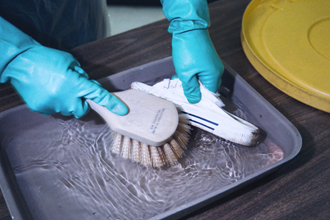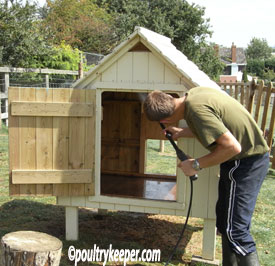Avian Influenza Biosecurity for Backyard Flock Owners
Section 2. Prevention
- Prevention
- Biosecurity
- Isolation
- Traffic Control
- Sanitation
- Decontamination
- Vaccination
- Registration
- Fairs, Shows, and Exhibits
- Surveillance and Monitoring
Equipment Decontamination Steps
|
 USDA APHIS
|
Poultry Housing
(Clean as needed)
|
 |
Sanitizing Poultry Drinking Water
If you use ponds, streams, or wells as your source of drinking water for your poultry, you should consider adding a sanitizer such as chlorine to the water. This will reduce the level of harmful organisms and other infectious agents in the water and prevent the buildup of slime in your waterers.
- Bleach may be used to sanitize water by adding 1 oz of bleach to 1 gallon of water.
- If giving a vaccine through the drinking water, stop using bleach to sanitize drinking water 2 days prior to vaccination as bleach will inactivate the vaccine and make it ineffective.
- Clean waterers and replenish with fresh water daily.
